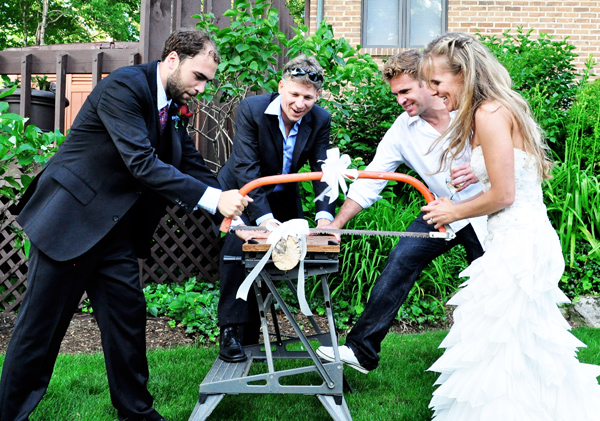Champagne, Bridal Soup and a Saw!
A traditional wedding day in Germany could actually last three days. First, German couples who are getting married must have a civil ceremony at the city center, which only family and close friends attend. After that a religious procedure is available. There is a large difference between a civil and a religious wedding. Civil wedding ceremonies are only possible inside the Registry office, and religious weddings can normally only be celebrated inside churches.
The majority of Germans marry in civil ceremonies. It is celebrated under the premise that at least one person is a (temporary) resident in Germany. The registration is done, in most cases, at the Standesamt in the city or town hall, or in a smaller town, at the police station. The non-resident may need to gather the required paperwork and obtain affidavits from a consulate or embassy. A civil wedding may be held a few days before the religious wedding.
Due to an old law in Germany, the application for the marriage license usually must be hung out at a public building for at least one week so that the general public is informed. Non-residents can make other arrangements through an international registry office (only four).
After the civil ceremony, the couple is joined by a number of friends and family (including those who witnessed the ceremony) and toasted with champagne. They then go to lunch.
The traditions of a religious ceremony are rather rich. In earlier years, a horse-drawn carriage with black horses transported the bridal couple to and from the church. Today, limousines and full sized cars are used. German brides do not have traditional wedding attendants except for flower girls.
The church where wedding takes place may be at a different location from the civil wedding. In Northern Germany, when a bridal pair is going to church, it is the custom, before they leave the house, to throw a firebrand on the threshold over which they must pass.
On the wedding morning, a breakfast called ‘morning soup’ or ‘bridal soup’ is served for the guests. Most weddings are held in the late morning. The groom calls for his and drives her to the church. Guests usually seat themselves. Usually the first pews are reserved for the family. The children walk as pages; little girls wear fresh flowered wreaths. Guests may be invited to the couple’s home, a banquet hall or country mansion for a reception. Champagne, white wine or schnapps may be served at the reception.
In many parts of Germany, when the priest joins the hands of the couple, the bride tries, to get the upper hand. The bridegroom tries to do the same, and often a struggle of hands ensues, which is sometimes settled by the priest placing the man’s hand uppermost. One of the pair, generally the bride, also tries for the same purpose to put her foot on top of the groom’s shoe. When the couple kneels during the ceremony, the groom may kneel on the hem of the bride’s gown, to symbolize he will keep her in order. The bride may step on his foot when she rises, to assert herself.
As the newlyweds leave the wedding chapel, they throw coins to the children watching.
When a couple exits the church after the ceremony, there is a saw horse that sports a thick log and a handsaw. The couple is expected to saw the log in half, symbolizing their taking on the first hard task of their new life together.
Related articles:
How to Saw a Log
German Wedding Tips
German Wedding Traditions
Getting Married in Germany
Wedding Traditions in Germany

